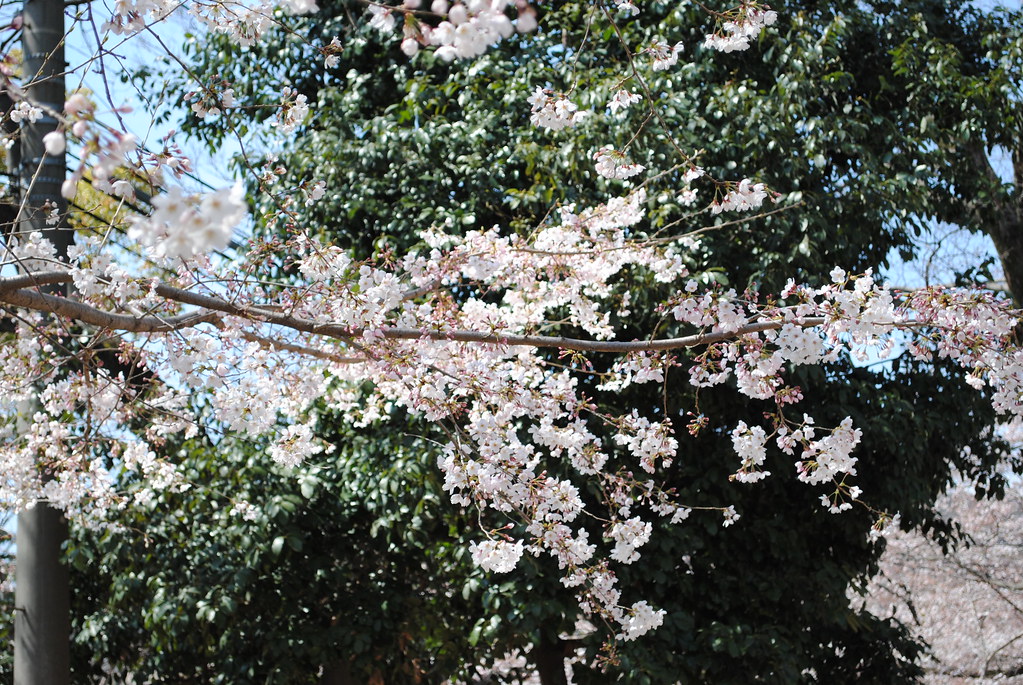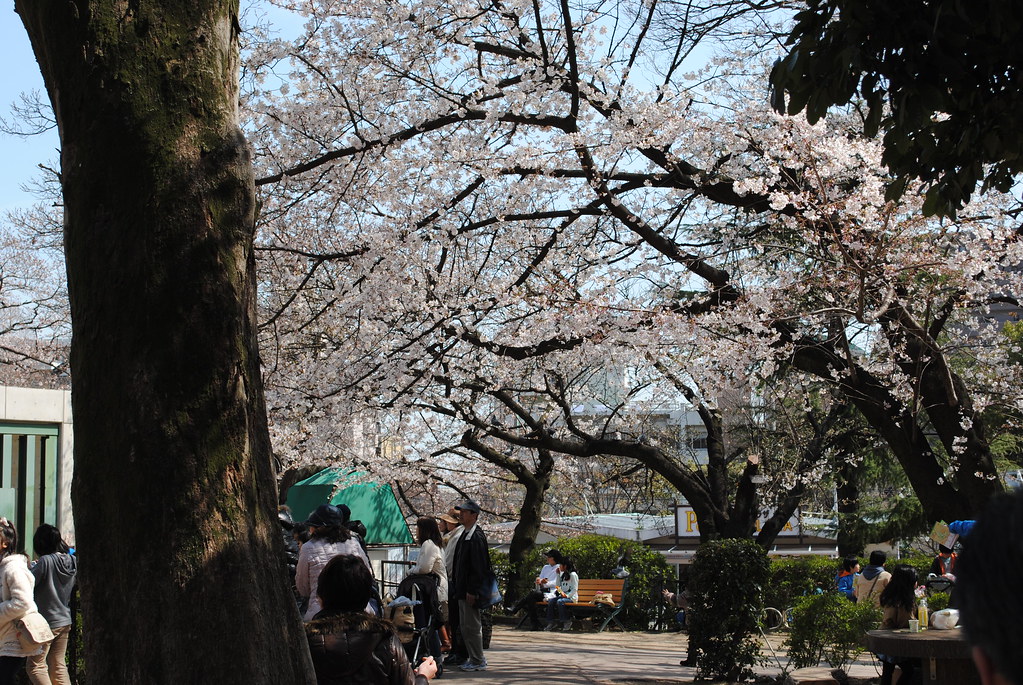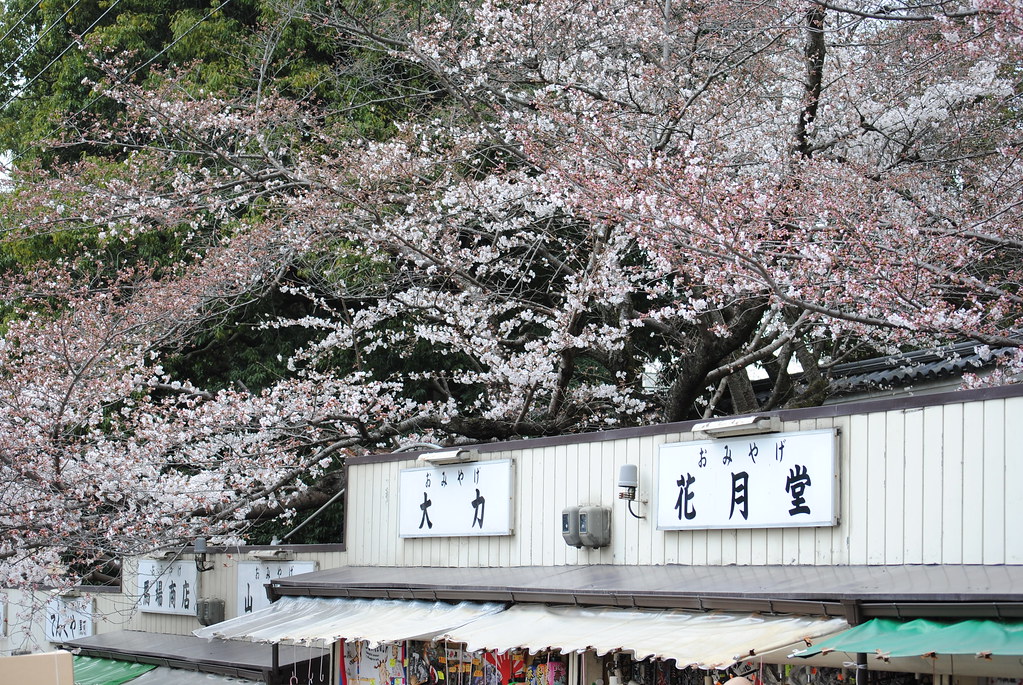On a language note, "the four seasons" can be formally written as 春夏秋冬 (しゅんかしゅうとう - shunkashuutou). It's just the kanji for spring, summer, autumn and winter stuck together which I think is very sensible. One of the teachers who sits next to me says that if you can use this when speaking to a Japanese person, they'll think you're "very cool".
While I think of it, if you find yourself getting confused between 春 (はる - haru - Spring) and 秋 (あき - aki - Autumn) like I used to, I'll teach you my trick. The word "spring roll" in Japanese is 春巻き (はるまき - harumaki) - literally "spring roll". If you can't remember if spring is "haru" or "aki", just remember that word - the "spring" in "spring roll" doesn't rhyme with "maki" - it would sound a bit strange if it was "akimaki". It worked for me!
春 is a time of new beginnings in Japan. The financial year starts on the 1st of April and the new school year begins about a week later, once 春休み (はるやすみ - haruyasumi - spring holidays) are over. The weather starts to warm up and the 桜 (さくら - sakura - cherry blossoms) come out in full force.
At this point, Japan goes 桜-crazy. Seasonal 桜 flavoured desserts and ice creams appear, 弁当 (べんとう - bento) boxes covered with 桜 stickers come out in the shops and the nightly news reports track the progress of the blooms all over the country. Needless to say, 花見 (はなみ - hanami - "cherry blossom viewing") is based around this. Friends, families and workmates plan picnics, walks and extravagant gatherings at local parks and castle grounds, eating 弁当 and drinking 日本酒 (にほんしゅ - nihonshu - sake) under the blossoms. Festival food stalls spring up at all the most popular spots for anyone who needs to fill up on more fried goodies. My local コンビニ (konbini - convenience store) has even helpfully set up a 花見 section with everything you need - picnic mats, plastic cutlery and all the most popular つまみ (tsumami - snacks) to take along.
Many Japanese people don't think too much about 花見, I'm told - for a lot of people, it's an excuse to have a big, noisy party. However, it's also a time when a lot of workers (and teachers) are transferred to different areas or divisions and many students start at new schools with different groups of people. It's a bittersweet time where you say goodbye to old friends and hello to new ones. Like the 桜, it was beautiful for the short time it lasted.
Many Japanese people don't think too much about 花見, I'm told - for a lot of people, it's an excuse to have a big, noisy party. However, it's also a time when a lot of workers (and teachers) are transferred to different areas or divisions and many students start at new schools with different groups of people. It's a bittersweet time where you say goodbye to old friends and hello to new ones. Like the 桜, it was beautiful for the short time it lasted.
And now we've hit on a big cultural idea. This is the key to one of the main tenets of Japanese culture and the reason why the 桜 are so important. In fact, people are usually referring to 桜 when they use the word 花 (はな - hana - flower), as you probably guessed from the word "花見". 花 is one of three kanji used in the phrase 雪月花 (せつげっか or せつげつか - setsugekka or setsugetsuka), meaning "snow, moon and flowers". You can sometimes see parts of this phrase like on this sign, which uses the second two kanji.
It's not used literally - it's a concept to make you think of Japan. All of these things - snow, the moon and the 桜 are all beautiful but fleeting - the snow melts, the moon gives way to the sun and the 桜 flutter to the ground and wither away. The word 花鳥風月 (かちょうふうげつ - kachoufuugetsu - "flower, bird, wind and moon") is similar - the appreciation of seasonal things for the brief time that they last. One of the teachers says that when she hears this, she imagines a windy night with a bird sitting on the branch of a cherry tree under the moonlight. This kind of thing is used a lot in haiku - not so much for literal meaning, but to paint a picture of Japan and its culture. Both phrases are a reference to the transience of life and how it should be enjoyed while it lasts.
And if there's anything the Japanese know how to do, it's enjoy themselves. At some point, you should try to make it over here during 春 and the parties of 花見. When you do, pull up a spot on the tarpaulin and have a look up at the 桜, then raise your glass to old and new friends, the fleeting beauty of the seasons, of the 桜 and of life. 乾杯 (かんぱい - kanpai - cheers)!!
It's not used literally - it's a concept to make you think of Japan. All of these things - snow, the moon and the 桜 are all beautiful but fleeting - the snow melts, the moon gives way to the sun and the 桜 flutter to the ground and wither away. The word 花鳥風月 (かちょうふうげつ - kachoufuugetsu - "flower, bird, wind and moon") is similar - the appreciation of seasonal things for the brief time that they last. One of the teachers says that when she hears this, she imagines a windy night with a bird sitting on the branch of a cherry tree under the moonlight. This kind of thing is used a lot in haiku - not so much for literal meaning, but to paint a picture of Japan and its culture. Both phrases are a reference to the transience of life and how it should be enjoyed while it lasts.
And if there's anything the Japanese know how to do, it's enjoy themselves. At some point, you should try to make it over here during 春 and the parties of 花見. When you do, pull up a spot on the tarpaulin and have a look up at the 桜, then raise your glass to old and new friends, the fleeting beauty of the seasons, of the 桜 and of life. 乾杯 (かんぱい - kanpai - cheers)!!




No comments:
Post a Comment
If you have any questions or additions, I would love to hear from you. I may not know the answer, but I'll do my best to find out in any case! You can post anonymously if you like, but abusive/unintelligible/inappropriate comments will not be published.